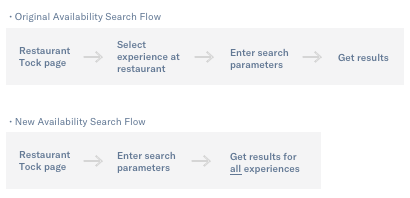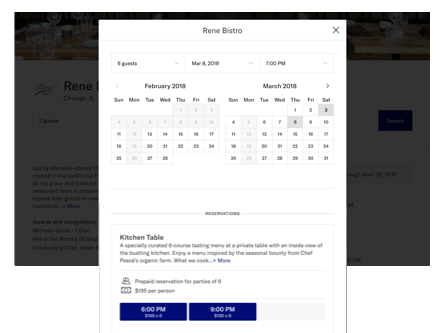Tock
Tock
Redesigning the Guest Booking Experience
Background
Tock began as a white-label product, providing a portal for restaurants to properly showcase and sell all the experiences they offered (think tasting menus, chef’s tables etc). In an effort to combat the industry plaguing issue of no-shows, Tock gave restaurants the ability to ask guests to pay for their experience (either in-full or a deposit) upfront in order to better ensure that guests would show up for their reservations.
This concept was inherently beneficial for restaurants, though it was an entirely new behavior for consumers — at least in the restaurant space. Consumers were familiar with the idea of paying upfront for other experiences: concerts, plays, flights etc. However, this was a new mental model when applied to booking dining reservations.
Our goals
Up until this point, we had been focused on the restaurant as our core user, building new product features with their needs in mind. However, we quickly recognized that we really had two user groups of equal importance: the restaurant and the guest booking at that restaurant. If we were going to ask consumers to change their mental model of how they book a reservation, we were going to need to gain their trust and start prioritizing their needs within the product.
The goal of the consumer-facing site redesign was to lay a foundation for a more guest-focused product.
Goal: Directly address the consumer.
Abandon our position as a white-label product and create a clearer story of who Tock is and what value we have to offer to the consumer. Ideally we wanted Tock to be known as a destination to discover and book amazing culinary experiences.
Goal: (Rich) content is king.
Guests love to be in the know - the more information about the restaurant the better. In order to both meet guest’s expectations of information found on a booking site and simultaneously improve the restaurant’s SEO, we needed to design a site composed of richer content.
Searching behavior
In rethinking the consumer experience, we wanted to maintain all the best parts about the original booking flow (of course) while simultaneously adding features to make up for previous shortcomings. No small task, and probably a bit over-zealous.
Aside from prioritizing the Tock brand in consumer facing flows, the most challenging feature we designed was the ability to search for availability across all experiences at a restaurant. At the time, a guest had to first select which experience they wanted to search within and then discover availability. This flow acted as a funnel, keeping the guest focused but also resulting in a lot of backtracking in-and-out of the flow. We recognized the need to widen the funnel, allowing guests to analyze and compare availability across all the experiences at a restaurant instead of just one.
Inventory challenges
Part of the beauty of our platform was the ability to accommodate a variety of restaurant concepts, allowing the even most esoteric restaurant concept (think 10 seats total with reservations only on every third Saturday of the month) to succeed. Being so flexible resulted in a large number of restaurant inventory patterns we needed to accommodate for. These challenges included but were not limited to:
• A pattern for surfacing availability that accommodated both restaurants with regular inventory and those with extremely varied inventory. A restaurant shouldn’t seem like they are “sold out” for the whole month if they really only offer reservations on a handful of days.
• How to deal with single day events and ensure guests were able to come across them when searching.
• When and where to surface prices and if the prices should include optional supplements in the cost.
• Thinking through high-volume ticket releases and how the system would work under intense conditions.
Launch V1
After 6 months of work, we were ready to launch V1. Reflecting back to the extensive feature list, a concrete rollout plan for this project was imperative.
This was one of the more important lesson I learned throughout the extent of this project. The devil is in the details when it comes to sharing news of a new consumer facing site with existing partners. Working side-by-side with our hospitality team allowed me to build empathy for the importance of getting partners excited about an update and feel like they were part of our product growth rather than being blindsided by the change.
Taking time to craft a proper rollout ensured that the majority of partners were advocates for the change and also became important sources of feedback as we iterated on the first launch.





